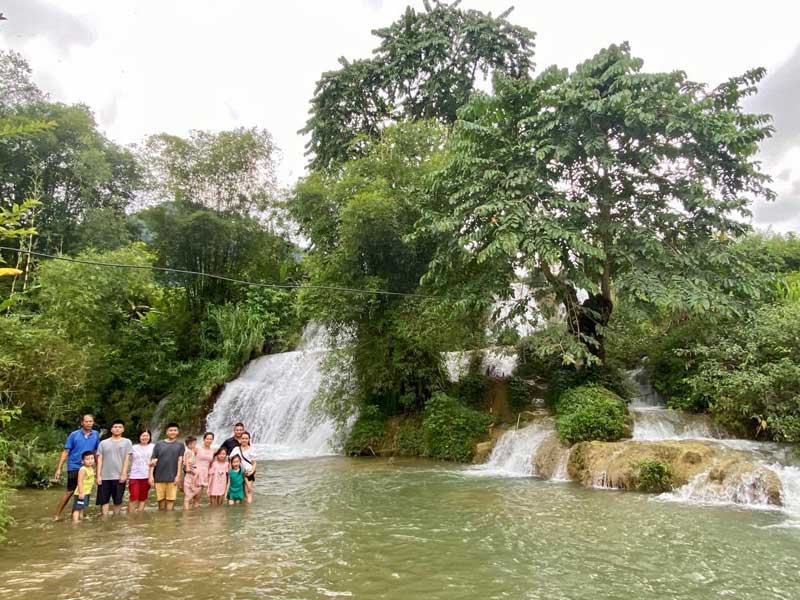


 The landscape of
Trang waterfall in Nhan My commune (Tan Lac) attracts a lot of tourists to
experience on the way exploring the community tourism of the ancient land in
Muong Bi.
The landscape of
Trang waterfall in Nhan My commune (Tan Lac) attracts a lot of tourists to
experience on the way exploring the community tourism of the ancient land in
Muong Bi.
The typical caves such as Thac Bo, Hoa Tien, Nam Son have been recognized as the national-level relics. Muoi Cave is a national archaeological relic and there is a number of provincial relics including Nui Kien cave, Cot Co mountain, the landscape of Trang waterfall, Ngoc Son - Ngo Luong Nature Reserve. In addition, there is a number of resource points such as the national-level relic – Muong Chieng cave, Chieng Khen rock roof (Man Duc town), Trong lake (Phong Phu commune), Phu Luong rocky mountain (Quyet Chien commune, Ngo Luong commune, Van Son district), the archaeological site at the national level, Bung cave in Suoi Hoa commune.
In particular, Tan Lac is an ancient land, the cradle of Hoa Binh culture, which is one of four major Muong regions (Bi, Vang, Thang, and Dong). The people here have been still retaining many cultural characteristics of Muong ethnic people such as the stilt houses, the national costumes, the lullabies, Bo Meng and Dum singing ... with many famous works (Laying land, laying water; Trang Dong), which has brought the profound thoughts, Mo Muong, and Muong gongs. A lot of customs and practices have still been preserved in weddings, funerals, in daily life and so on.
In recent years, the community tourism in Tan Lac has started to develop with 2 hamlets, Luy Ai in Phong Phu commune and Ngoi in Suoi Hoa commune.
About 1 km far from the National Highway 6, the community tourism point in Luy Ai village is the pioneer model of the community tourism. The area of the village is nearly 1.5 square kilometer, located in a small valley surrounded by hills, there is Ai stream of clear, clean and fresh water, and it is a long-standing residence of Muong ethnic people with more than 50 traditional stilt houses lying on the hill sides. The tangible and intangible cultural heritages bearing bold identity of the Muong have been kept. In Ai village there are also many terraced fields for cultivating water rice. Near Cot Co Mountain (Khu Doi), there are a lot of other landscapes such as Trang waterfall, Trong lake, and many other beautiful places such as Hoa Tien cave, Ngoi Hoa bay. The village has been recognized by the Ministry of Culture, Sports and Tourism as one of the 20 typical traditional villages of the ethnic minorities.
Since 2019, there has been two more community tourism spots in the district, namely Chien village in Van Son commune and Buoi Cai village in Phu Cuong commune. Currently, there are 4 community tourism spots coming into operation, and there are more than 10 households having homestays, attracting and creating jobs for over 60 local workers. In particular, Ai village has become the main tourism destination located in the tourism route of the National Highway 6, the typical Northwest inter-regional tourism route. Some other villages such as Chieng, Tac Trong, Lu in Van Son commune, Bac Thung in Quyet Chien commune, Trang Ta commune in Nhan My commune, Tham in Suoi Hoa commune also have many potentials to develop into community tourism destinations.
In order to have a breakthrough, creating a mark to attract domestic and international tourists in the community tourism, the district has been focusing on diversifying the products of community tourism such as staying at the houses of the local people, experiencing the village life, participating in the folk-culture festivals, learning about the local traditional culture. They have also been experiencing the life of a farmer through farming, planting, breeding and participating in the activities of seasonal farming and harvesting. Learning trecking, exploring the ecosystem, walking or cycling around the village, visiting the waterfalls, the landscapes and the rice fields, experiencing and participating in daily and rustic activities of Muong ethnic people are also very popular. The district has been paying attention in building souvenir products and tourism gifts, contributing to increasing the attractiveness of the destination, encouraging spending, and promoting effective tourism images.
By 2025 the district is trying to build 12 community tourism destination with 30 homestays, in which there are 5 establishments with 2 stars or more. The number of visitors coming to the community tourism destinations will reach 54,000 turns, increasing about 32,000 turns compared to 2019, and the revenue from community tourism will reach over 27 billion VND. By 2030, 100% of the local community tourism sites will meet the requirements of the local tourism sites. An image of community tourism of Tan Lac will be built in the Northern midland and mountainous region.